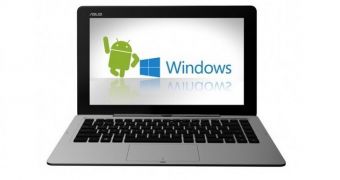According to reports a few weeks ago, Microsoft and Google have apparently teamed up to put a stop to devices running both Windows and Android like the ASUS Transformer Book Duet.
The machine was introduced at CES 2014, but due to constant pressure form the two companies, the device never made it on the market and probably never will. Then there was talk of a Huawei Android/Windows phone in the works, but the company subsequently announced it was pulling the plug on the project.
These developments shouldn't come as a big shock, since Google and Microsoft are competing entities and the idea of keeping things separate apparently prevailed with both. Google has made it pretty clear they don’t consider Android to be a laptop or desktop OS, which is what Chrome is for.
But putting aside Google and Microsoft, dual-boot devices would have had to pass the customers’ test. And the question is, would have they sold?
For the moment, the only dual-boot machines available on the market right now are the ASUS Transformer Book Trio (in laptop mode, it runs Windows; take the keyboard away and you have an Android slate) and the Transformer AIO desktop/tablet.
But until now these two models haven’t proved to be more than niche products. Sure, we might be curious about them, but are they really worth our money?
Hybrid devices will need extra hardware to function. The Transformer Book Trio is a Windows PC at its base and has a different set of tablet-dedicated hardware. Granted, ASUS’ partner Intel has come up with chips that can support both OSes, which takes a lot of the hassle away, but even so dual-boot devices will need some extra hardware to accommodate the specific needs of the different OS-s (like extra ports, storage).
Of course, extra hardware translates into more weight and a heftier price. For example, the Transformer Book Trio weighs 3.7 pounds / 1.6 kg and is thick enough to compare it to a laptop. More hardware also means less space for a powerful and large battery.
Pricing is another issue here, as the Trio sells for a hefty $1,300 / €945, a price that will keep the average consumer at bay.
Of course, breakthroughs in hardware design might as well fill in the above-mentioned caveats, but it’s quite doubtful most users who use tablets/laptops for browsing, media streaming and office related work, might grasp the complete implications of having dual-OS.
Think about it, give a dual-OS machine to somebody and they will likely spend more time with one of them, neglecting the other. So why pay premium to have both?
Basically, most tech users out there want a simple device that lets one do a lot of stuff in an easy, intuitive way. A machine built to be the answer for each and every one of your needs is bound to be a very complex piece of equipment, which will take time and effort to understand.
So why not have an Android tablet and Windows PC instead, you’ll probably end up cheaper this way too.

 14 DAY TRIAL //
14 DAY TRIAL //